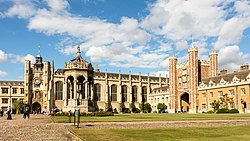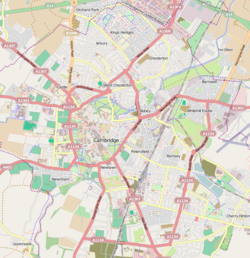
Back كلية الثالوث (كامبريدج) Arabic ترينيتى كوليدچ (كامبريدج) ARZ Triniti Kolleci (Kembric) Azerbaijani Трыніці-каледж (Кембрыдж) Byelorussian Тринити Колидж (Кеймбридж) Bulgarian ট্রিনিটি কলেজ, কেমব্রিজ Bengali/Bangla Trinity College (Cambridge) Catalan Trinity College (Cambridge) Czech Тринити-колледж (Кембридж) CV Coleg y Drindod, Caergrawnt Welsh
| Trinity College | |
|---|---|
| University of Cambridge | |
 Trinity College Great Court
Scarf colours: navy, with three equally-spaced narrow stripes, the outer stripes of yellow and slightly narrower, the central stripe of red and slightly wider Trinity College scarf | |
 Coat of arms of Trinity College Arms: Argent, a chevron between three roses gules barbed and seeded proper and on a chief gules a lion passant gardant between two closed books all Or | |
| Location | Trinity Street (map) |
| Full name | The College of the Holy and Undivided Trinity within the Town and University of Cambridge of King Henry the Eighth's Foundation |
| Latin name | Collegium Trinitatis |
| Motto | Virtus Vera Nobilitas[1] (Latin) |
| Motto in English | Virtue is true nobility |
| Founder | Henry VIII of England |
| Established | 1546 |
| Named after | The Holy Trinity |
| Previous names | King's Hall and Michaelhouse (until merged in 1546) |
| Sister college | Christ Church, Oxford |
| Master | Dame Sally Davies |
| Vice-Master | Professor Louise Merrett |
| Undergraduates | 735 (2022–23) |
| Postgraduates | 336 (2022–23) |
| Senior tutor | Professor Catherine Barnard[2] |
| Endowment | £2.19bn (2023)[3] |
| Visitor | |
| Website | trin |
| Students' union | www |
| BA society | basociety |
| Map | |
Trinity College is a constituent college of the University of Cambridge.[5] Founded in 1546 by King Henry VIII, Trinity is one of the largest Cambridge colleges,[6] with the largest financial endowment of any college at Oxford or Cambridge. Trinity has some of the most distinctive architecture in Cambridge with its Great Court said to be the largest enclosed courtyard in Europe.[7] Academically, Trinity performs exceptionally as measured by the Tompkins Table (the annual unofficial league table of Cambridge colleges), coming top from 2011 to 2017,[8] and regaining the position in 2024.[9]
Members of Trinity have been awarded 34 Nobel Prizes out of the 121 received by members of the University of Cambridge (more than any other Oxford or Cambridge college).[10] Members of the college have received four Fields Medals, one Turing Award and one Abel Prize.[11] Trinity alumni include Francis Bacon, six British prime ministers (the highest number of any Cambridge college), physicists Isaac Newton, James Clerk Maxwell, Ernest Rutherford and Niels Bohr, mathematicians Srinivasa Ramanujan and Charles Babbage, poets Lord Byron and Lord Tennyson, English jurist Edward Coke, writers Vladimir Nabokov and A. A. Milne, historians Lord Macaulay and G. M. Trevelyan, and philosophers Ludwig Wittgenstein and Bertrand Russell (who the college expelled before reaccepting). Two members of the British royal family have studied at Trinity and been awarded degrees: Prince William of Gloucester and Edinburgh, who gained an MA in 1790, and King Charles III, who was awarded a lower second class BA in 1970.
Trinity's many college societies include the Trinity Mathematical Society, the oldest mathematical university society in the United Kingdom, and the First and Third Trinity Boat Club, its rowing club, which gives its name to the May Ball. Along with Christ's, Jesus, King's and St John's colleges, it has provided several well-known members of the Cambridge Apostles, an intellectual secret society. In 1848, Trinity hosted the meeting at which Cambridge undergraduates representing fee-paying private schools codified the early rules of association football, known as the Cambridge rules.[12] Trinity's sister college is Christ Church, Oxford. Trinity has been linked with Westminster School since the school's re-foundation in 1560, and its Master is an ex officio governor of the school.[13]
- ^ James, Simon (4 August 2008). Latin Matters: A Little Knowledge Is A Dangerous Thing. Pavilion Books. ISBN 9781906032319 – via Google Books.
- ^ "Fellows of Trinity College, Cambridge". Archived from the original on 8 November 2021. Retrieved 26 April 2023.
- ^ "Annual Record of Trinity College, Cambridge (pg 237)". Retrieved 15 June 2024.
- ^ Cite error: The named reference
statuteswas invoked but never defined (see the help page). - ^ Walker, Timea (21 January 2022). "Trinity College". www.undergraduate.study.cam.ac.uk. Retrieved 2 November 2022.
- ^ Kirk, Ashley; Peck, Sally (1 October 2019). "Why Trinity is the best Cambridge college, according to our Oxbridge league table". The Telegraph. ISSN 0307-1235. Archived from the original on 20 February 2020. Retrieved 24 March 2021.
- ^ Stephen Brewer, Donald Olson (2006). Best Day Trips from London: 25 Great Escapes by Train, Bus Or Car. Frommer's. p. 56. ISBN 0-470-04453-5.
- ^ "Exclusive: Christ's triumphant in 2019 Tompkins Table". Archived from the original on 7 November 2020. Retrieved 7 February 2021.
- ^ "Trinity tops 2024 Tompkins Table as Christ's is toppled". 23 September 2024.
- ^ "Research at Cambridge/Nobel Prize". University of Cambridge. 28 January 2013. Archived from the original on 28 January 2017. Retrieved 8 August 2021.
- ^ "Famous Trinity College Medallists and Prize Winners". Trin.cam.ac.uk. Archived from the original on 28 November 2020. Retrieved 28 August 2020.
- ^ Murray, Bill; Murray, William J (1 January 1998). The World's Game: A History of Soccer. University of Illinois Press. ISBN 9780252067181. Archived from the original on 1 May 2022. Retrieved 22 November 2020.
- ^ "Westminster School Intranet". Intranet.westminster.org.uk. Archived from the original on 13 July 2012. Retrieved 25 March 2010.

